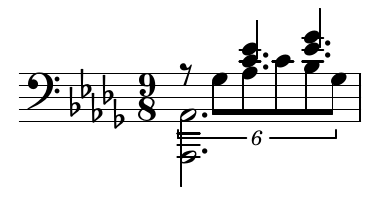Here is the original fragment I am trying to engrave:
Here is my naive approach:
\version "2.24.3"
\language "italiano"
\new Staff <<
\relative do' {
\key reb \major
\numericTimeSignature
\time 9/8
\clef bass
<<
{
s4. <do mib>4. <mib solb>4.
} \\
{
\tuplet 6/9 {r8 solb, [lab do sib solb]} |
} \\
{
\voiceTwo
<lab, lab,>2.
}
>>
}
>>
The result is puzzling:
How can I fix it?
Update
After a lot of documentation search, and experimenting, here is my best version so far
\version "2.24.3"
\language "italiano"
\new Staff <<
\relative do' {
\key reb \major
\numericTimeSignature
\time 9/8
\clef bass
<<
{
\tupletDown
\override Stem.direction = #DOWN
\tuplet 6/9 {
r8 solb _[lab do sib solb]
} |
} \\
{
\override Stem.direction = #UP
s4. <do mib>4. <mib solb>4.
} \\
{
\override Stem.direction = #DOWN
<lab,,, lab'>2.
}
>>
}
>>
Any idea how to shift the first chord so it doesn't interfere with the tuplet?






